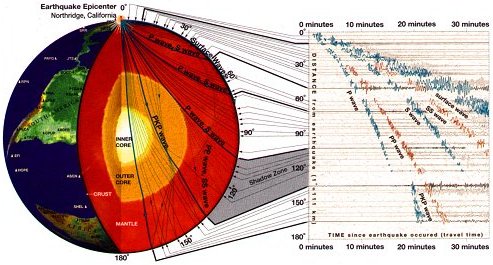IRIS Educational Materials
| Education & Outreach Series | No. 5 |
| Exploring the Earth Using Seismology | |
Earthquakes create seismic waves that travel through the Earth. By analyzing these seismic waves, seismologists can explore the Earth’s deep interior. On January 17, 1994 a magnitude 6.9 earthquake near Northridge, California released energy equivalent to almost 2 billion kilograms of high explosive. The earthquake killed 51 people, caused over $20 billion in damage, and raised the Santa Susana Mountains north of Los Angeles by 70 centimeters. It also created seismic waves that ricocheted throughout the Earth’s interior and were recorded at geophysical observatories around the world. The paths of some of those seismic waves and the ground motion that they caused are shown below. | |
On the right, the horizontal traces of ground motion (seismograms recorded at various locations around the world) show the arrival of the different seismic waves. Although the seismic waves are generated together, they travel at different speeds. Shear waves (S waves), for example, travel through the Earth at approximately one-half the speed of compressional waves (P waves). Stations close to the earthquake record strong P, S and Surface waves in quick succession just after the earthquake occurred. Stations farther away record the arrival of these waves after a few minutes, and the times between the arrivals are greater. At about 100 degrees distance from the earthquake, the travel paths of the P and S waves start to touch the edge of the Earth’s outer core. Beyond this distance, the first arriving wave — the P wave — decreases in size and then disappears. P waves that travel through the outer core are called the PKP waves. They start to appear beyond 140 degrees. The distance between 100 and 140 degrees is often referred to as the “shadow zone”. We do not see shear (S) waves passing through the outer core. Because liquids can not be sheared, we infer that the outer core is molten. We do, however, see waves that travel through the outer core as P waves, and then transform into S waves as they go through the inner core. Because the inner core does transmit shear energy, we assume it is solid. A poster version (100 by 70 cm) of this figure is available from the IRIS Consortium. |
|
IRIS is a university research consortium dedicated to monitoring the Earth and exploring its interior through the collection and distribution of geophysical data. IRIS programs contribute to scholarly research, education, earthquake hazard mitigation, and the verification of the Comprehensive Test Ban Treaty. Support for IRIS comes from the National Science Foundation, other federal agencies, universities, and private foundations. The seismic monitor was developed by the IRIS Consortium, US Geological Survey, University of Colorado, and Reel Illusions Multimedia, Inc. 1200 New York Ave., NW #800 |
|
| This educational material is reproduced with permission from the IRIS Consortium. | |
|
To obtain a copy of " Education & Outreach Series No. 5"
in Adobe PDF format, To request preprinted copies of any or all of the Education & Outreach Series, please send your request to info@iris.edu (please include the handout volume number and quantity needed for each). |
|
|
updated 02/10/14 |
|




